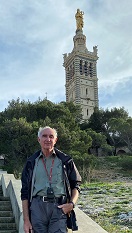


|
|
|
|||||||||||||||
|
|
||||||||||||||||
|
|
|||
|
|
Marseille Notre-Dame de la Garde
The first chapel was built in there 1214 and this was replaced at the beginning of the 15th century by a larger building which was dedicated to Saint Gabriel, this building was completed in 1443, but later this was transformed into a fort and a third chapel was built. The construction of the Catholic Basilica of Our Lady of the Guard began in 1852 on the foundations of a 16th-century fort erected by Francis I of France to guard against the siege of Marseille by the Emperor Charles V in 1536. Construction of the basilica was to take 21 years. Originally the work was to enlarge the existing chapel, but this developed into the basilica, which was consecrated on the 5th June 1864 even though it was at that time still unfinished. The exterior of the building is in layered stonework in the contrasting colours of white Calissane limestone and green Golfolina sandstone. A 35 m (115 ft) double staircase leads to a drawbridge, providing access to the crypt and, via another set of stairs, to the church's main entrance. 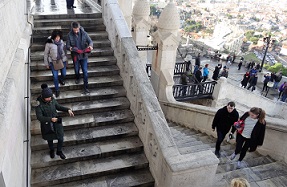 The work on the existing basilica started on the crypt, which was hewn out of the rock and was carried out in Romanesque style. The crypt comprises of a nave with low barrel vaults. 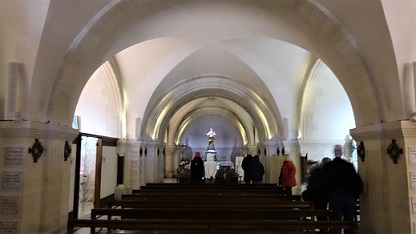 At the side are six chapels. These each contain an altar dedicated to a particular saint and display plagues acknowledging the various donors who contributed to is construction. 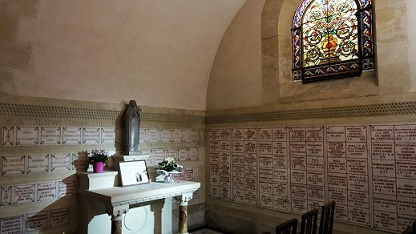 To be found in the crypt is a wooden statue of Christ, and a statue of Christ lying in the tomb. The upper part of the basilica consists of an upper church in the Neo-Byzantine style. This is entered through the entrance which overlooks the city and a statue of the Passion of Christ. 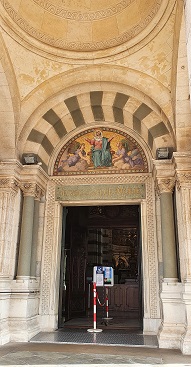 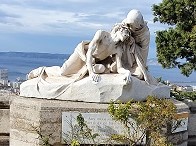 The nave's interior is divided into three equal parts, each with a central window providing light to a side chapel. 32.7 m long and 14 m wide and decorated with 1,200 m of mosaics. The side chapels measure 3.8 m by 5.4 m and has a ceiling decorated with a mosaic. Each chapel depicts the name and coat of arms of the financer on one side and a symbol of the saint on the other. Within the chapels are the plaques donated by those who made a request with regard to a particular aspect, being that with regard to the safe return of a loved one at sea or from an illness. 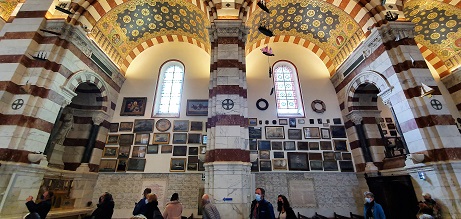 The high altar is made from white and gilded marble. On either side is a column in coral pink marble. The mosaic panel depict doves drinking from a cup. The floors are covered with mosaics with a geometric pattern. Located behind the main altar is a statue of the Virgin with a bouquet and the infant Jesus. 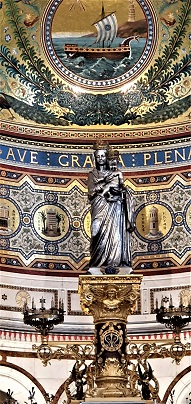 This statue was obtained in 1804 for the original chapel. The Madonna originally held a sceptre, but due to its poor condition, it was replaced by flowers. The mosaic of the apse's semi-dome depicts a ship in its central medallion. The ship's sail features the monogram of Mary, while a star in the sky shows an intertwined A and M, which stands for Ave Maria. This medallion is surrounded by thirty-two birds, including peacocks, parrots, bluethroats, herons, and goldfinches. The ceiling has three cupolas also decorated with mosaics depicting flowers and doves with each cupola being of a different colour. Medallions on the pendentives (a constructive device permitting the placing of a circular dome over a square room or an elliptical dome over a rectangular room.) depict scenes from the Old Testament. 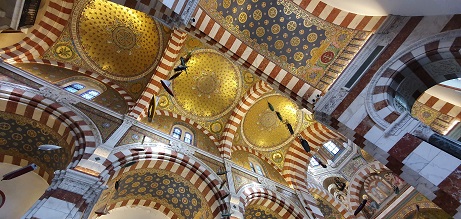 The transept is oriented east to west and lit by two paired windows, each of which has a rose window above. Situated above the crossing of the transept is a dome nine meters in diameter, composed of thirty-two ribs and crowned by a cross. Inside of the dome is a mosaic of four angels on a field of gold. 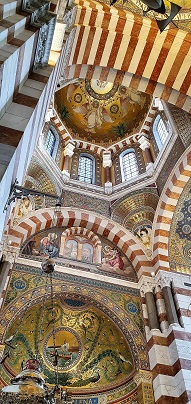 The angels are holding a wreath of roses which they offer to the Virgin Mary, represented by her monogram. The pendentives at the base of the dome contain representations of the Four Evangelists: Mark symbolized by a lion, Luke by a bull, John by an eagle and Matthew by a man. The other main part of the basilica is the bell tower. This standson a square terrace measuring 41 meters square and is 12.5 meters (41 ft) high. 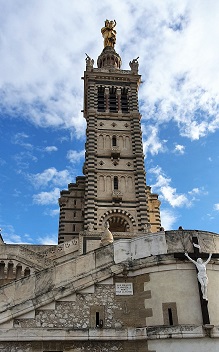 It is made of sixteen red granite columns.The bell tower has an entrance porch with two identical storey’s consisting of five blind arches. The central arch has a window and small balcony. Above this is a belfry which is covered by a square terrace surrounded by a stone balustrade. On this are angels with a trumpet at each corner. At the top of the belfry is a copper statue of the Madonna and Child 11.2 meters (37 ft) high gilded with gold leaf. A spiral staircase within the tower leads to the terrace and to the statue, but this is not open to the public. The bell itself was cast in 1845 and fixed on 15th October 1845, it measures 2.4 m in diameter and 2.5 m in height. At the base of the tower, bronze doors provide access to the church. The central door panels bear the monogram of the Virgin placed within a circle of pearls resembling the rosary. The site underwent a major restoration between 2001 and 2008. |
|
|
|
|
|||
All Photographs were taken by and are copyright of Ron Gatepain
| Site Map |
